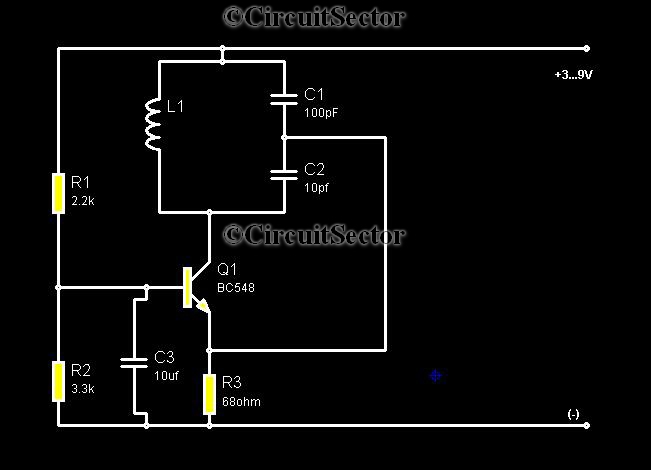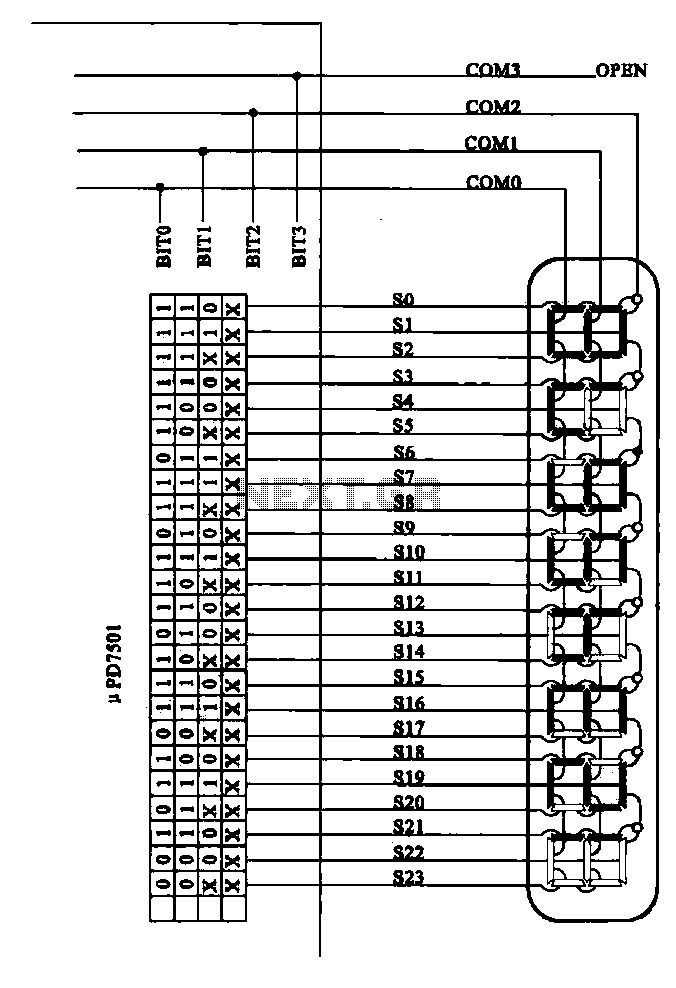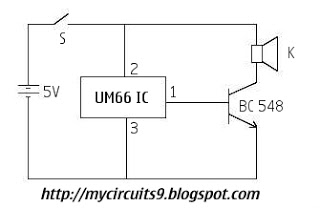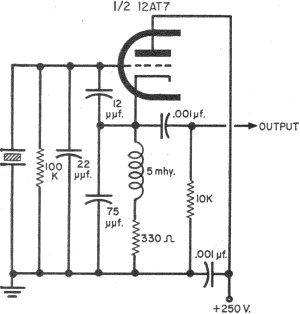
555 electronic circuit diagram of a Christmas tree

The circuit features a clock pulse generator and a pulse distribution circuit that drives the display circuit. It consists of a 555 timer and resistors RP1, R1, R2, along with capacitor C1, forming an astable multivibrator. The oscillation frequency is determined by the formula f = 1.44 / ((RP1 + R1 + 2R2) * C1), allowing for an adjustable oscillation period T ranging from 0.5 to 15 seconds. The output serves as a count clock for the IC2, which is a decimal counter and pulse distributor (CD4017). Under the influence of the clock signal, outputs Q0 through Q9 sequentially produce high pulses, with the pulse width corresponding to the clock cycle. This triggers transistors VT1 to VT6 into saturation, subsequently illuminating light-emitting diodes (LED1 to LED31) in a festive arrangement reminiscent of a Christmas tree. After the IC2 counts to seven, transistors VT5 and VT1 are activated in succession, lighting up LEDs 28 and 1 in turn, creating an endless cycle.
The circuit operates as follows: The astable multivibrator, constructed using the 555 timer, continuously generates a square wave output. The frequency of oscillation is adjustable through the resistors and capacitor selected, allowing the user to customize the blinking rate of the LEDs. The output from the 555 timer is fed into the CD4017 counter, which divides the frequency and produces a series of high pulses across its outputs Q0 to Q9.
Each high pulse activates a corresponding transistor (VT1 to VT6), which in turn drives the connected LEDs. The arrangement of the LEDs is designed to create a visually appealing display, lighting up in a sequential pattern that enhances the festive atmosphere. The design ensures that as the counter reaches a count of seven, a specific sequence of LEDs (LED28 and LED1) is illuminated, providing a distinct visual cue before the cycle restarts.
This circuit is ideal for decorative lighting applications, particularly during festive seasons where visual effects are desired. The use of a 555 timer ensures reliability and ease of adjustment, while the CD4017 counter efficiently manages the distribution of the pulse signals to the transistors and LEDs, resulting in a synchronized lighting effect that can captivate viewers. The overall design is straightforward, making it accessible for both hobbyists and professionals interested in creating dynamic lighting displays. As shown, the circuit includes a clock pulse generator, and a pulse distribution circuit drives the display circuit. 555 and RP1, R1, R2, C1 composition astable multivibrator, the oscillation frequency f 1.44/(RP1 + R1 + 2R2) C1. Oscillation period T 1/f 0.5 to 15 seconds, adjustable. Its output as the count clock IC2, IC2 decimal counter/pulse distributor CC4017, under the clock action, Q0 ~ Q9 successively appear high pulse, the pulse width of the clock cycle, the corresponding VT1 VT6 turn saturated conduction, the corresponding light-emitting diodes LED1 ~ LED31 various quarters were lit like a Christmas tree properly arranged, like the stars shine, enhance the festive atmosphere. After IC2 count seven, VT5 VT1 saturated conduction sequentially, LED28 LED1 lit in turn. Again and again, endless cycle.
The circuit operates as follows: The astable multivibrator, constructed using the 555 timer, continuously generates a square wave output. The frequency of oscillation is adjustable through the resistors and capacitor selected, allowing the user to customize the blinking rate of the LEDs. The output from the 555 timer is fed into the CD4017 counter, which divides the frequency and produces a series of high pulses across its outputs Q0 to Q9.
Each high pulse activates a corresponding transistor (VT1 to VT6), which in turn drives the connected LEDs. The arrangement of the LEDs is designed to create a visually appealing display, lighting up in a sequential pattern that enhances the festive atmosphere. The design ensures that as the counter reaches a count of seven, a specific sequence of LEDs (LED28 and LED1) is illuminated, providing a distinct visual cue before the cycle restarts.
This circuit is ideal for decorative lighting applications, particularly during festive seasons where visual effects are desired. The use of a 555 timer ensures reliability and ease of adjustment, while the CD4017 counter efficiently manages the distribution of the pulse signals to the transistors and LEDs, resulting in a synchronized lighting effect that can captivate viewers. The overall design is straightforward, making it accessible for both hobbyists and professionals interested in creating dynamic lighting displays. As shown, the circuit includes a clock pulse generator, and a pulse distribution circuit drives the display circuit. 555 and RP1, R1, R2, C1 composition astable multivibrator, the oscillation frequency f 1.44/(RP1 + R1 + 2R2) C1. Oscillation period T 1/f 0.5 to 15 seconds, adjustable. Its output as the count clock IC2, IC2 decimal counter/pulse distributor CC4017, under the clock action, Q0 ~ Q9 successively appear high pulse, the pulse width of the clock cycle, the corresponding VT1 VT6 turn saturated conduction, the corresponding light-emitting diodes LED1 ~ LED31 various quarters were lit like a Christmas tree properly arranged, like the stars shine, enhance the festive atmosphere. After IC2 count seven, VT5 VT1 saturated conduction sequentially, LED28 LED1 lit in turn. Again and again, endless cycle.
Warning: include(partials/cookie-banner.php): Failed to open stream: Permission denied in /var/www/html/nextgr/view-circuit.php on line 713
Warning: include(): Failed opening 'partials/cookie-banner.php' for inclusion (include_path='.:/usr/share/php') in /var/www/html/nextgr/view-circuit.php on line 713





